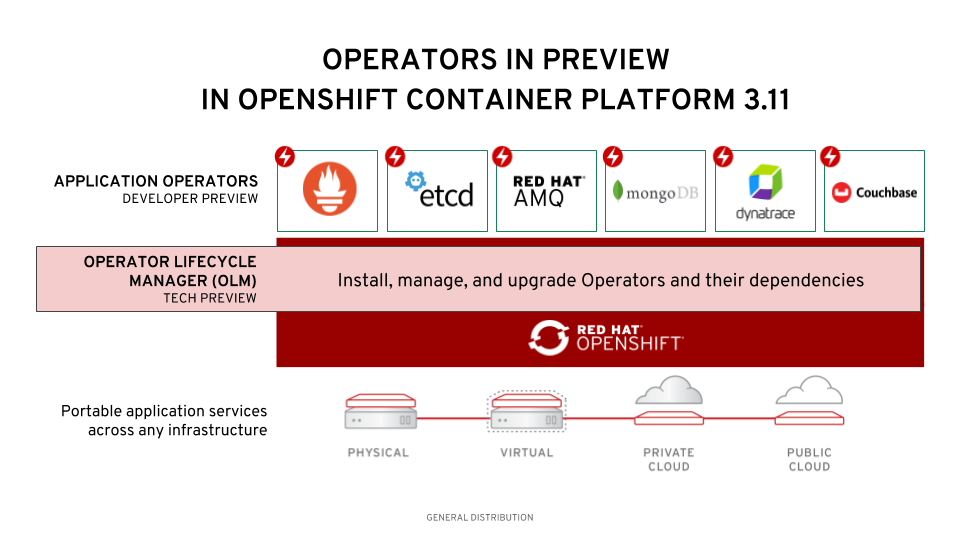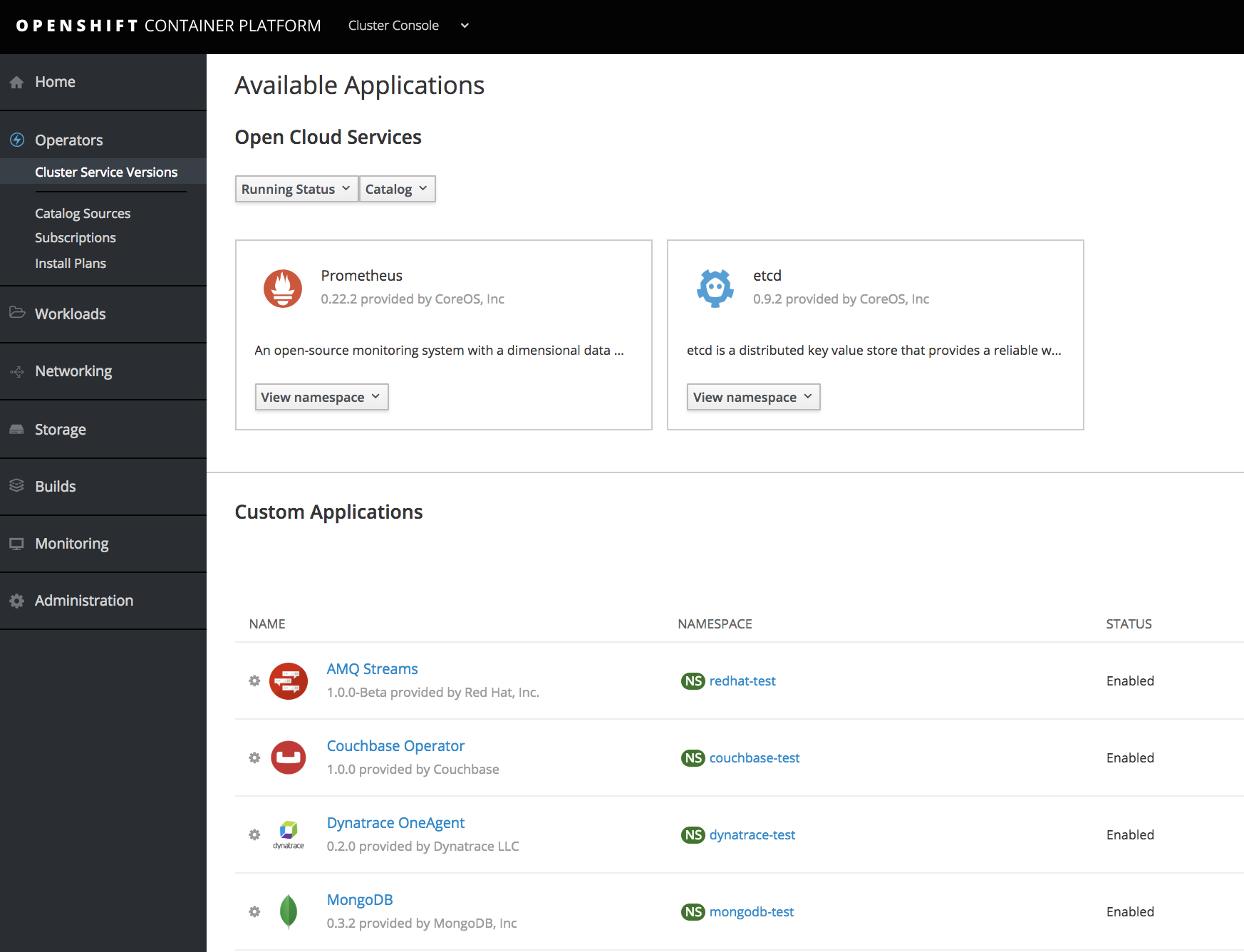Day 2 operations with updated console and Operator capabilities
Today, Red Hat OpenShift Container Platform 3.11, a comprehensive, leading enterprise Kubernetes platform, is generally available and ready for download (see the release notes and download OpenShift here). OpenShift Container Platform 3.11 ships with Kubernetes 1.11, along with several notable features to better streamline Day 2 cluster and application operations. In short, we’ve made central administration for your clusters, environments, and users easier, while providing expanded Prometheus capabilities for gathering Kubernetes-native metrics.
Incorporating CoreOS Technologies for Day 2 Operations
When CoreOS joined Red Hat earlier this year, we knew our combined team could draw on greater expertise and leadership to further refine and expand our enterprise Kubernetes platform. OpenShift Container Platform 3.11 is designed to deliver on our converged roadmap plans with several newly-incorporated features.
Admin-Focused Console
While Red Hat OpenShift already has a developer-friendly user console, with OpenShift Container Platform 3.11, we’re adding a more administrator-focused experience based on that in CoreOS Tectonic. This cluster console includes new views for Red Hat OpenShift Container Platform administrators to manage nodes, roles-based access controls, and other underlying cloud infrastructure objects.
 Both the application and cluster consoles will ship with OpenShift Container Platform 3.11. With OpenShift, organizations are gaining a powerful DevOps platform: developer teams can continue to view and access the services, containers, and deployment tools they need through the application console, while administrators can gain greater visibility to handle and monitor clusters, nodes, and users through the cluster console.
Both the application and cluster consoles will ship with OpenShift Container Platform 3.11. With OpenShift, organizations are gaining a powerful DevOps platform: developer teams can continue to view and access the services, containers, and deployment tools they need through the application console, while administrators can gain greater visibility to handle and monitor clusters, nodes, and users through the cluster console.
Kubernetes-Native Metrics and Alerts
Prometheus metrics and alerts
While the cluster console enhances visibility for IT, today’s deployments can still require scalable tooling for metrics collection, log aggregation, and alerting. What’s more, all that information needs to be turned into human digestible information. Prometheus, a CNCF project that collects time-series data as a source for triggering alerts, has emerged as a leading standard for cloud-native monitoring within Kubernetes. Red Hat (via CoreOS) spotted the potential for Prometheus early on, and now drives considerable upstream work for the project. In OpenShift Container Platform 3.11, Prometheus is GA for cluster monitoring.
Getting the technology in place is not the only thing needed to enable a higher quality monitoring experience out of the box. OpenShift pre-configures a set of monitors and alerts for the Kubernetes control plane. Our engineers have embedded their years of expertise running and troubleshooting Kubernetes for customers like UPS, Lufthansa Technik and Cathay Pacific. These include monitoring critical dependencies like etcd, which is sensitive to network and disk latency. To help map cluster scaling to your usage, a set of control plane-focused alerts shows end-to-end scheduling latency, failed API operations, capacity planning views, and other important drill downs.
Of course, the control plane is just one part of your cluster. We’re also offering the Prometheus Operator as Developer Preview in OpenShift Container Platform 3.11 to enable your engineering teams to configure and run their own monitoring services for their applications, with variable metric retention and other configurations to be specific to their needs.
Grafana dashboards
Visibility into microservice and container native infrastructure performance can put more power in the hands of administrators. In addition to the cluster console, OpenShift Container Platform 3.11 ships with Grafana dashboards for greater visibility. Grafana is designed to help teams visualize and better analyze their time series data. Teams can review more detailed data about important metrics and the included alerts without getting bogged down in a complex query language or command console.
With the cluster console, Prometheus, and Grafana dashboards, OpenShift Container Platform customers can have more confidence that they’ll get a broad view of their Kubernetes clusters’ performance, with the drill-down capabilities they may require.
Kubernetes Operators on OpenShift
Also in this release are a number of previews around Operators, which are Kubernetes-native applications and services. Operators encode the human operational knowledge normally required to help keep services running optimally, helping to reduce manual work and helping to execute best practices within milliseconds of an anomaly occurring, designed to return to the desired state you’ve defined for your system.
Today, we’re extending Operator capabilities to OpenShift in a preview capacity. In addition to Prometheus, etcd, and AMQ Streams Operators, we’re introducing the first set of Operators on OpenShift from our ISV partners. Our partners have built these Operators using the Operator SDK, part of the Operator Framework project announced by Red Hat earlier this year.
The following Operators are available in OpenShift Container Platform 3.11 as Developer Preview, with optional install:
- Couchbase Autonomous Operator: Couchbase is a multi-modal distributed NoSQL database that offers in-memory performance combined with the flexibility and persistence of a JSON document store. Couchbase Autonomous Operator takes advantage of Couchbase’s service isolation for multi-dimensional scaling (out or up) that is well suited for cloud-native and container-based apps. Generally available since September and in Dev Preview in Red Hat OpenShift 3.11 for our Operators Lifecycle Manager, Couchbase Autonomous Operator enables automated configuration, creation, scaling, and recovery of Couchbase clusters while providing native integration of Couchbase Server with Red Hat OpenShift.
- Dynatrace OneAgent Operator: Dynatrace’s full stack monitoring is designed to provide deep code-level visibility into container-based applications automatically. With auto-discovery, Dynatrace traces transactions across cloud native environments, mapping inter-dependencies at the application, process, service, and host layer. AI-powered problem identification and root cause analytics can provide real-time answers to problems wherever they occur, including the container and node level. The Dynatrace Operator can take care of installing and updating the OneAgent pod in OpenShift, helping to remove manual efforts.
- etcd Operator: etcd is a distributed key-value store that is designed to provide a reliable way to store data across a cluster of machines. This Operator, built by Red Hat, enables users to configure and manage the complexities of etcd using a declarative configuration that creates, configures, and manages etcd clusters.
- MongoDB Operator: MongoDB is a distributed, transactional database that stores data in flexible, JSON-like documents. The Operator supports deploying both production-ready replica sets and sharded clusters, and standalone dev/test instances. It works in conjunction with MongoDB Ops Manager, enabling all clusters to be deployed according to operational best practices.
- Prometheus Operator: Prometheus is a cloud native monitoring system co-hosted with Kubernetes within the CNCF. This Operator, built by Red Hat, is for use with containerized applications and includes application domain knowledge designed to take care of common tasks like create/destroy, simple configuration, automatic generating of monitoring target configurations via labels, and more.
- Red Hat AMQ Streams Operator: Red Hat AMQ Streams is a massively scalable, distributed, and high performance data streaming platform based on the Apache Kafka project. It offers a distributed backbone that is designed to allow microservices and other applications to share data with higher throughput and lower latency.
These Operators have been validated to work for non-production use cases with Red Hat OpenShift, and like all Operators, on any Kubernetes cluster. In OpenShift Container Platform 3.11, installation, management, and dependencies for the Operators themselves are handled by the Operator Lifecycle Manager (OLM) from the Operator Framework (OLM is shipping as Tech Preview in OpenShift Container Platform 3.11).

While still in Developer Preview, application Operators on OpenShift Container Platform 3.11 provide follow up to our ISV partnership program announced at Red Hat Summit, and we’re excited about our partners’ contributions and hope to receive more feedback on usage of the Operators.

Kubernetes Operators are available through the cluster console in OpenShift 3.11. Follow the installation guide to install them on your cluster. Partners interested in getting involved in the Operator program can join the Early Adopter Program through Red Hat, learn more through the Operator Framework SIG (part of OpenShift Commons) and the Operator Framework community, and check out all Community Operators on the community page on OpenShift Commons.
Introducing OpenShift Container Engine
As we’ve worked to integrate CoreOS technologies into OpenShift, we’ve also learned more about a broader set of customers. While there is a set of companies that value the pluggable container infrastructure and developer lifecycle automation capabilities of OpenShift Container Platform, there is also a set which would prefer to use the advanced DevOps, networking, and management tooling and capabilities which they have already been using. For this segment, today we’re introducing OpenShift Container Engine. OpenShift Container Engine offers the same enterprise Kubernetes platform for which Red Hat and OpenShift are known, but excludes some of the extended capabilities of OpenShift Container Platform. Read more about what’s included and what’s driving our release of OpenShift Container Engine on our related blog post, reach out to your Red Hat representative, or contact us directly to learn more.
Next Steps
OpenShift Container Platform 3.11 is an exciting release for us as we continue to focus on delivering on our converged roadmap with CoreOS. We encourage you to learn more about what’s coming and catch up on what you might have missed.
Learn more about Operators and the Operator Framework:
- GET STARTED: Installation and usage; get started with the etcd Operator
- DO MORE: Building and creating with the Operator SDK; try it with the Memcached Operator
Join us on October 18, 2018 at 9 a.m. US Pacific Time for an OpenShift Commons Briefing to learn more about OpenShift Container Platform 3.11.